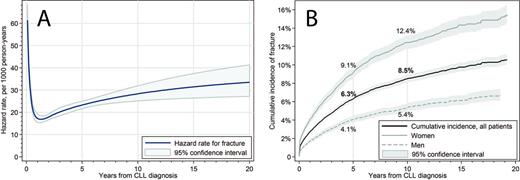Abstract
Introduction: Chronic lymphocytic leukemia (CLL) largely affects older patients (median age, 71 years). It is often characterized by indolent course, often requiring no therapy until patients develop symptomatic lymphadenopathy, anemia or thrombocytopenia, but very little is known about health risks during prolonged watchful waiting, which may last many years. CLL has been associated with vitamin D deficiency, progressive bone marrow expansion and bone remodeling. Chemotherapy in lymphomas, which often includes steroids, is known to increase risk of fractures. We hypothesized that the risk of clinically significant vertebral and other fractures is also increased among older patients with untreated CLL.
Methods: We identified patients aged ≥65 years, diagnosed with CLL in 1992-2012, using the linked Medicare and Surveillance, Epidemiology and End Results (SEER-Medicare) data base. We excluded autopsy cases and those with incomplete Medicare records. Using validated algorithms based on inpatient and outpatient health services, we calculated for each patient the date of chemotherapy initiation, and time to first vertebral, hip, pelvic or femur fracture within the timeframe from the CLL diagnosis to the start of chemotherapy (or censoring). We compared the hazard of fracture among the untreated CLL patients with a 5% random sample of Medicare beneficiaries without cancer in proportional hazard models fitted on age-attained scale, stratified by sex, race, calendar year of entry into the risk pool, and disability status. For confirmation, we generated a cohort of CLL cases and non-cancer controls matched by those stratification variables, and compared the hazards of fracture. Cumulative incidence function (CIF) and risk factors for fractures were studied using competing risk analysis. Models report hazard ratios (HR) or subhazard ratios (SHR) with 95% confidence intervals (CI).
Results: We identified 21,015 CLL patients, with median age of 77.5 years, of whom 56% were male and 91% were white non-Hispanic. Median time from CLL diagnosis to first chemotherapy was 5.8 years. During this period of observation a fracture was recorded in 1,690 cases (8%), with crude incidence rate of 16.7 (per 1000 person-years) for men and 34.7 for women. The respective incidence rates among non-cancer controls were 7.7 for men and 16.3 for women.
In adjusted models, patients with CLL under watchful waiting had a significantly higher hazard of any fracture compared with the non-cancer population (HR, 1.42, CI, 1.34-1.51). This increase was not significantly different for men (HR, 1.42, CI, 1.28-1.59) and women (HR, 1.47, CI, 1.36-1.58). The risk was significantly higher for pelvic (HR, 1.68, CI, 1.45-1.95), vertebral (HR, 1.47, CI, 1.34-1.62) and hip fractures (HR, 1.28, CI, 1.18-1.38), but not for femur fracture (HR, 1.11, CI, 0.91-1.35). The higher risk of all fractures, and of pelvic, vertebral and hip fractures was confirmed in the matched case/control analysis. The hazard rate of incident fracture increased with time from CLL diagnosis (Fig. A).
Accounting for the competing risks of death and chemotherapy, CIF for any fracture in CLL was 6.3% after 5 years of watchful waiting (CI, 6.0-6.7%, Fig. B) and 8.5% (CI, 8.1-8.9%) after 10 years. CIF for competing events at 5 years was 37.4% for initiation of chemotherapy and 27.5% for intercurrent death without treatment. CIF at 5 years was 2.4% for vertebral, 3.4% for hip, 0.9% for pelvic, and 0.5% for femur fracture. In a multivariable model, CIF increased with age, was significantly higher in women (SHR, 1.98, CI, 1.79-2.20), in patients with poor baseline performance status (SHR, 1.64, CI, 1.35-1.99), and with a history of fracture before CLL diagnosis (SHR, 1.79, CI, 1.52-2.11), but it was lower among black patients (SHR, 0.50, CI, 0.37-0.68) and those with higher comorbidity index.
Conclusions: We discovereda significantly increased risk of fractures, particularly of the spine and pelvis, among olderpatients undergoing watchful waiting for CLL. Further research is needed to establish if the increasing hazard over time correlates with the leukemic burden in the marrow or if it is just a function of age. The incidence rate of fractures in CLL is comparable to osteoporosis, warranting study of prophylactic interventions. Untreated CLL patients may need more active supportive management than mere observation endorsed by current guidelines.
Olszewski:Genentech, Inc.: Research Funding; Bristol-Myers Squibb, Inc.: Consultancy.
Author notes
Asterisk with author names denotes non-ASH members.


This feature is available to Subscribers Only
Sign In or Create an Account Close Modal